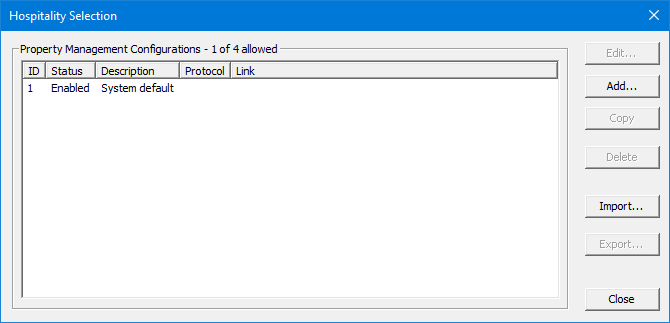Hospitality
Hospitality features are provided to support the unique needs of the hospitality industry, such as simplified mailboxes for guest use and integration with a property management system (PMS). The 7.00 includes a service module that, when active, controls communication with the PMS over either an RS232 serial link or a TCP/IP network connection and also communicates via TCP/IP to client applications such as InnDesk and PMS Monitor.
The settings accessed through System Configuration allow you to configure the serial or TCP port used by the hospitality service, specify which communication protocol to use, and configure other hospitality-related settings.
This dialog lists the key information for each configured server:
| Column | Description |
|---|---|
| ID | Server ID, used when assigning a PMS link to a location. |
| Status | Indicates if the link is enabled or disabled. |
| Description | Configurable name or description; blank by default. |
| Protocol | Assigned communication protocol; must match protocol used by the PMS. |
| Link | Link configuration. For serial, it displays the COM port number. For TCP/IP client, it displays the PMS IP address and the TCP port number. For TCP/IP server, it displays the TCP port number. |
Edit a Server
To configure a server, select the server instance in the table and click Edit to open the editor for that server.
Add or Copy a Server
To add the next available server instance, click Add. Or, to create the next server instance based off an existing one, select the server to copy in the list and then click Copy. Either way, the configuration dialog will be opened to edit it. In the case of a copy, the editor will be populated with the setting values for the server instance copied from; otherwise, it will have default values instead.
At a minimum, you will need to change the assigned COM or TCP port and give it a unique name or description in the Description field on the General tab.
The maximum number of PMS instances that can be created is 99.
Delete a Server
To remove the last server instance in the list, click Delete. The 7.00 requires the hospitality server ID numbers to be in order, starting from 1. Thus, you are only allowed to delete the last entry in the list. For example, if there are three server instances, you cannot delete server 2 without first deleting server 3.
At least one server is required at all times, even if a PMS is not in use. Therefore, server instance 1 will always exist and cannot be deleted.
Import / Export
Hospitality configurations can be exported for backup or for import on other systems.
Import
Import can only be performed while the system is not running and you can either import a configuration as a new hospitality server or overwrite an existing one based on the number of hospitality servers allowed.
Once a new configuration has been imported, verify the connection type and any COM port or IP addresses.
Export
Exports a file which can be used as a backup or for import onto systems with similar configuration.
